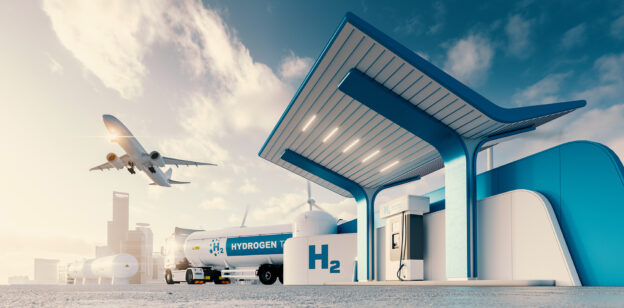While California transitioned to hydrogen and electric vehicles in response to pollution in Los Angeles, the Norwegian government enacted legislation mandating zero-emission technologies for the UNESCO World Heritage Geiranger Fjord, with the requirement set to take effect by 2026. Norwegian Hydrogen AS is already in the process of developing the Hellesylt Hydrogen Hub within Geiranger Fjord, a small-scale prototype hub scheduled to open in 2024.
The concept for the hydrogen hub in Norway was conceived by Knut Flakk, the CEO of Flakk Gruppen, which gave rise to Hexagon Composites and Hexagon Purus. To turn this vision into reality, he assembled a consortium of industrial investors, which included Flakk Gruppen, Hexagon Purus, Hofseth International, and Tafjord Kraftproduksjon, to establish the engineering and infrastructure company known as Norwegian Hydrogen AS in 2020. In 2022, Mitsui & Co., Ltd. became the second-largest investor and majority owner. Mitsui’s extensive investment portfolio has opened up numerous opportunities for Norwegian Hydrogen to engage in global collaborations.
The Hellesylt Hydrogen Hub serves as a prototype facility and presents a unique opportunity for the company to conceptualize, construct, and operate a comprehensive hydrogen ecosystem. Hydrogen production, amounting to 1.3 tons per day, will be made possible by tapping into local hydropower sources, utilizing up to 3 MW of power through electrolysis. For this purpose, the gEL600 system from German FEST green H2systems have been selected. This includes three 1MW stacks from Plug Power with a combined daily production above 1,3 tonnes. Furthermore, the waste heat generated by these electrolyzers will be harnessed to benefit the Hellesylt community. The project is well underway and is scheduled for commissioning in 2024.
For these hubs Norwegian Hydrogen also deploys a remarkable application for oxygen produced by electrolysis. When water is split via electrolysis to produce hydrogen, the by-product, oxygen, is typically vented into the atmosphere. However, in this case, an innovative approach is taken. To maximize the utilization of all elements within this ecosystem, the surplus oxygen can be effectively used in fish farming. Traditional fish farming operations often involve fish growing in smaller water volumes than in their natural habitats, necessitating the aeration of water to provide the fish with adequate oxygen. By replacing externally supplied liquid oxygen with locally produced oxygen as by-product, substantial cost savings can be realized for fish farms co-located with hydrogen hubs. One of the key stakeholders in Norwegian Hydrogen, Hofseth International, Norway’s leading salmon exporter to the U.S., envisions direct benefits from hydrogen electrolysis production for its fish farming members.
In addition to the current project, Norwegian Hydrogen has embarked on several other significant ventures. Another planned hydrogen hub, known as FjordH2, is on an entirely different scale, nearly a hundred times larger, boasting renewable hydropower electrolysis capabilities of up to 250 MW when fully developed. This hub will be situated in Ørskog, within the Ålesund municipality of Norway, and is poised to become one of the largest green hydrogen production facilities in the entire Nordic region. The electrolysis plant itself will have an impressive annual production capacity of 40,000 tonnes of green hydrogen. Norwegian Hydrogen is partnering with Provaris, an Australian company specializing in storage and transport marine vessels designed for compressed hydrogen at around 250 bar. The destination for this hydrogen will be Europe, where it will address the increasing demand for green hydrogen, as the EU plans to import 10 million tonnes annually in 2030.
“When we decided to move forward with our growth strategy, it was a deliberate and well calculated decision. That is why we’re not spending a lot of time on the if’s, but instead on the how’s, when’s and where’s. We have already developed a great project pipeline and will continue to grow this as our international roll-out plan is set in motion.”, states Jens Berge, CEO Norwegian Hydrogen.


Vireon hydrogen station concept
NORWEGIAN HYDROGEN AS
Moreover, Norwegian Hydrogen has established Vireon AS, a hydrogen fueling infrastructure brand with the aim of becoming the leading operator of hydrogen refueling stations for heavy transport in the Nordics. Through substantial investments in land transportation infrastructure, Norwegian Hydrogen seeks to expedite the adoption of hydrogen-powered heavy-duty transport in the region. To accelerate this process and tap into expertise in the field, Vireon has forged a collaboration with First Element Fuel, a prominent builder and operator of hydrogen stations in California. It’s worth noting that First Element is also a part of the Mitsui portfolio, which is concurrently investing in Vireon through Norwegian Hydrogen. Additionally, Norwegian Hydrogen is actively pursuing various government funding opportunities. For instance, the Swedish government has granted $2 million for a station capable of dispensing approximately 1,500 kg of hydrogen per day. Furthermore, several more projects are in the pipeline, particularly in the co-production sphere, where hydrogen is already being generated for other applications, thus enabling shared investment in fueling infrastructure.
Jens Berge continues, “We have established a team that is capable and motivated to move us in the right direction, and will continue to recruit the best people. We’re in it for the long run, and we need top talent with the same unwavering dedication.”
Norwegian Hydrogen is actively expanding its portfolio of projects, seamlessly integrating land-based and maritime applications, with the projects mentioned here being just a glimpse of their business. This rapid growth is underpinned by substantial investments, supportive government regulations in the EU and Nordic regions, and the establishment of strategic collaborations on a global scale.
https://www.forbes.com/sites/davidblekhman/2023/10/12/hydrogen-hub-prototype-in-norwegian-fjords-nordic-notes/amp/





